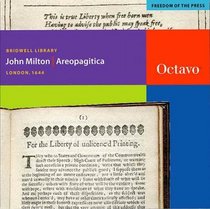Search -
Areopagitica
Areopagitica
Author:
When John Milton wrote Areopagitica in 1644, he was not making a contribution to the great debate on church versus state or the limits of toleration, except incidentally. Areopagitica was the result of the response to his Doctrine and Discipline of Divorce the previous year. Advocating divorce seemed to strike at the roots of any religious socie... more »
Author:
When John Milton wrote Areopagitica in 1644, he was not making a contribution to the great debate on church versus state or the limits of toleration, except incidentally. Areopagitica was the result of the response to his Doctrine and Discipline of Divorce the previous year. Advocating divorce seemed to strike at the roots of any religious socie... more »
ISBN-13: 9781891788093
ISBN-10: 1891788094
Publication Date: 7/1998
Pages: 44
Rating: 2
ISBN-10: 1891788094
Publication Date: 7/1998
Pages: 44
Rating: 2
4.8 stars, based on 2 ratings
Publisher: Octavo
Book Type: CD-ROM
Other Versions: Paperback, Hardcover
Members Wishing: 0
Reviews: Amazon | Write a Review
Book Type: CD-ROM
Other Versions: Paperback, Hardcover
Members Wishing: 0
Reviews: Amazon | Write a Review
Genres:
- History >> Europe >> England >> General
- Literature & Fiction >> Books & Reading >> Antiquarian & Rare Books
- Literature & Fiction >> Books & Reading >> Book Banning
- Literature & Fiction >> British & Irish >> Classics >> Milton, John
- Religion & Spirituality >> Authors, A-Z >> ( M ) >> Milton, John
- Nonfiction >> Philosophy >> Political
- Nonfiction >> Politics >> Freedom & Security >> Censorship




